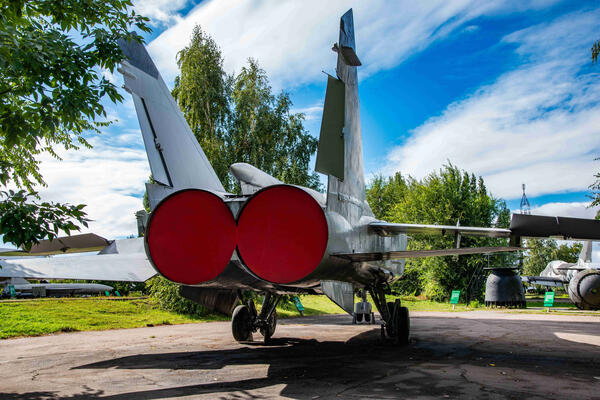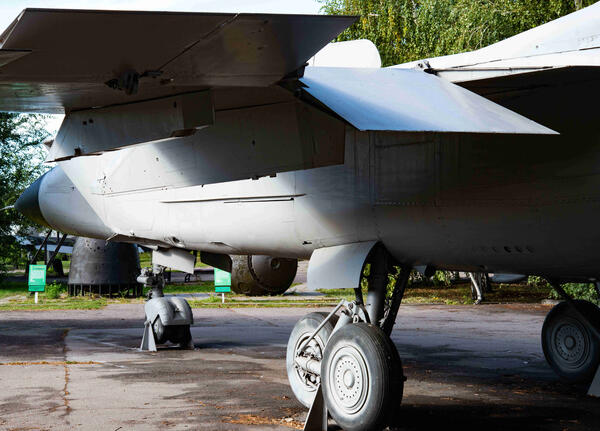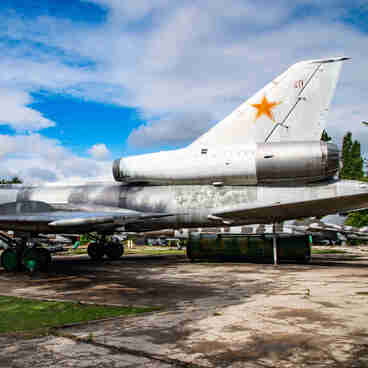When the strategic cruise missiles were developed and entered service with the United States, the USSR sought to design a more advanced fighter-interceptor. It had to be capable of dealing with the new threat.
The MiG-31 fighter-interceptor was developed in the design bureau of the Moscow Machine-Building Plant “Zenit” in the early 1970s. The project was led by Konstantin Konstantinovich Vasilchenko.
The two-seat supersonic fighter-interceptor MiG-31 officially entered service with the Soviet Air Defense Forces in 1981. The MiG-31 had a classic aerodynamic design with a trapezoidal high wing, an all-moving stabilizer and a twin tail.
The airframe was built using stainless steel (50%), titanium (16%), aluminum alloys (33%), and other structural materials (1%). Thus, the weight of the fighter-interceptor was reduced.
The aircraft weapon system allowed the MiG-31 to be used both autonomously and as part of a group of similar aircraft. In addition, it could act as a leader aircraft to control the actions of fighters that had less advanced avionics.
The aircraft was designed to destroy all types of aerial targets, including small cruise missiles, helicopters and high-altitude supersonic aircraft. It was capable of performing combat tasks at any time of day and night, in normal and difficult weather conditions, as well as when the enemy used active and passive radar interference or even deployed flares.
The MiG-31 is practically the only aircraft capable of intercepting and destroying cruise missiles at extremely low altitudes. Furthermore, the MiG-31 was armed with a six-barreled 23mm cannon with 260 rounds of ammunition.
The MiG-31 fighters were not used in any armed conflicts. They were produced mainly to re-equip the aviation regiments that protected the skies in the Arctic and the Far East. They were manufactured at the Gorky Aviation Plant until 1994. About 500 units of all modifications were built.
The MiG-31 fighter-interceptor was developed in the design bureau of the Moscow Machine-Building Plant “Zenit” in the early 1970s. The project was led by Konstantin Konstantinovich Vasilchenko.
The two-seat supersonic fighter-interceptor MiG-31 officially entered service with the Soviet Air Defense Forces in 1981. The MiG-31 had a classic aerodynamic design with a trapezoidal high wing, an all-moving stabilizer and a twin tail.
The airframe was built using stainless steel (50%), titanium (16%), aluminum alloys (33%), and other structural materials (1%). Thus, the weight of the fighter-interceptor was reduced.
The aircraft weapon system allowed the MiG-31 to be used both autonomously and as part of a group of similar aircraft. In addition, it could act as a leader aircraft to control the actions of fighters that had less advanced avionics.
The aircraft was designed to destroy all types of aerial targets, including small cruise missiles, helicopters and high-altitude supersonic aircraft. It was capable of performing combat tasks at any time of day and night, in normal and difficult weather conditions, as well as when the enemy used active and passive radar interference or even deployed flares.
The MiG-31 is practically the only aircraft capable of intercepting and destroying cruise missiles at extremely low altitudes. Furthermore, the MiG-31 was armed with a six-barreled 23mm cannon with 260 rounds of ammunition.
The MiG-31 fighters were not used in any armed conflicts. They were produced mainly to re-equip the aviation regiments that protected the skies in the Arctic and the Far East. They were manufactured at the Gorky Aviation Plant until 1994. About 500 units of all modifications were built.





